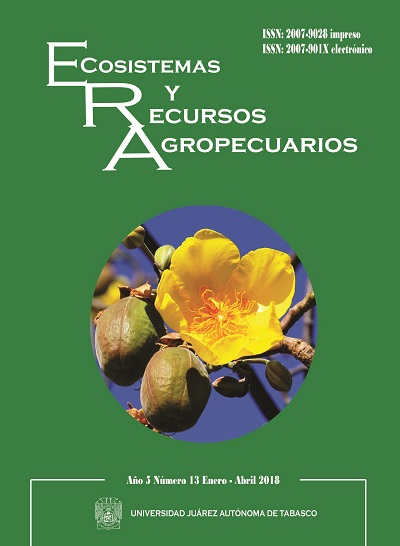Lunar phobia in phyllostomid bats at La Ceiba, Tuxpan, Veracruz
DOI:
https://doi.org/10.19136/era.a5n13.1033Keywords:
Abundancia, Chiroptera, diversidad, fases lunares, riquezaAbstract
The term lunar phobia is used to explain the behavior that some nocturnal animals have to avoid periods with greater moonlight intensity. The aim was to determine the effect of the brightness of the new moon and the full
moon on the richness, abundance and diversity of the phyllostomid bat community at the La Ceiba estate, Tuxpan, Veracruz, where the study was conducted from October 2013 to February 2014 using five mist nets for two nights per month. We captured 142 bats belonging to eight species, with Artibeus lituratus being the species with the highest records in both lunar phases (74 individuals). Although no signicant differences were found in diversity between the two lunar phases, greater cumulative species richness and abundance were recorded in the new moon (eight species, 118 individuals) than the full moon (five species, 24 individuals). The signicant decrease in abundance between the new moon and the full moon, mainly of small frugivorous species, indicates that lunar luminosity affects bat activity. It also has an effect on total species richness as three species were exclusively recorded in the new moon phase.
Downloads
Downloads
Published
Issue
Section
License
Aviso de copyright
Los autores que se envían a esta revista aceptan los siguientes términos:
una. Los autores conservan los derechos de autor y garantizan a la revista el derecho a ser la primera publicación del trabajo con una licencia de atribución de Creative Commons que permite a otros compartir el trabajo con un reconocimiento de la autoría del trabajo y la publicación inicial en esta revista.
B. Los autores pueden establecer acuerdos complementarios separados para la distribución no exclusiva de la versión del trabajo publicado en la revista (por ejemplo, en un repositorio institucional o publicarlo en un libro), con un reconocimiento de su publicación inicial en esta revista.
C. Se permite y se anima a los autores a difundir su trabajo electrónicamente (por ejemplo, en repositorios institucionales o en su propio sitio web) antes y durante el proceso de envío, ya que puede conducir a intercambios productivos, así como a una cita más temprana y más extensa del trabajo publicado. (Consulte El efecto del acceso abierto).

